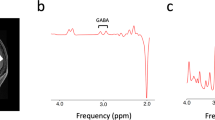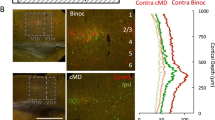Abstract
Background/objectives
Obesity leads to changes in synaptic plasticity. We aimed at investigating the impact of bariatric surgery (RYGB) on visual neural plasticity (NP) and its relationship with the main gut peptides, leptin, and brain-derived neurotrophic factor (BDNF).
Subjects/methods
NP was assessed testing binocular rivalry before and after 2 h of monocular deprivation (index of visual brain plasticity) in 15 subjects with obesity (age 42.3 ± 9.8 years; BMI 46.1 ± 4.9 kg/m2) before and after RYGB. Gut peptides, leptin, and BDNF were obtained at baseline and 6 months after surgery in 13 subjects.
Results
A significant reduction in BMI (p < 0.001 vs. baseline) and a significant increase of disposition index (DI, p = 0.02 vs baseline) were observed after RYGB. Total and active GLP-1 release in response to glucose ingestion significantly increased after RYGB, while no changes occurred in VIP, GIP, and BDNF levels. Fasting leptin concentration was lower after RYGB (p = 0.001 vs. baseline). Following RYGB, NP was progressively restored (p < 0.002). NP was correlated with DI and fasting glucose at baseline (r = 0.75, p = 0.01; r = −0.7, p = 0.02; respectively), but not with BMI. A positive correlation between post–pre-RYGB changes in AUCactive GLP−1 and NP was observed (r = 0.70, p < 0.01). Leptin was inversely correlated with NP 6 months after surgery (r = −0.63, p = 0.02). No correlation was observed between GIP, VIP, BDNF, and NP.
Conclusions
Visual plasticity is altered in subjects with obesity, and it can be restored after RYGB. The improvement may be mediated by amelioration of insulin sensitivity, increased GLP-1 levels, and reduced leptin levels.
This is a preview of subscription content, access via your institution
Access options
Subscribe to this journal
Receive 12 print issues and online access
$259.00 per year
only $21.58 per issue
Buy this article
- Purchase on Springer Link
- Instant access to full article PDF
Prices may be subject to local taxes which are calculated during checkout



Similar content being viewed by others
References
Hruby A, Hu FB. The epidemiology of obesity: a big picture. Pharmacoeconomics. 2015;33:673–89.
Geijselaers SLC, Sep SJS, Stehouwer CDA, Biessels GJ. Glucose regulation, cognition, and brain MRI in type 2 diabetes: a systematic review. Lancet Diabetes Endocrinol. 2015;3:75–89.
Karlsson HK, Tuulari JJ, Hirvonen J, Lepomaki V, Parkkola R, Hiltunen J, et al. Obesity is associated with white matter atrophy: a combined diffusion tensor imaging and voxel-based morphometric study. Obesity. 2013;21:2530–7.
Balistreri CR, Caruso C, Candore G. The role of adipose tissue and adipokines in obesity-related inflammatory diseases. Mediators Inflamm. 2010;2010:802078.
Heni M, Kullmann S, Preissl H, Fritsche A, Häring HU. Impaired insulin action in the human brain: causes and metabolic consequences. Nat Rev Endocrinol. 2015;11:701–11.
Sripetchwandee J, Chattipakorn N, Chattipakorn SC. Links between obesity-induced brain insulin resistance, brain mitochondrial dysfunction, and dementia. Front Endocrinol. 2018;9:496.
Stagg CJ, Bachtiar V, Johansen-Berg H. The role of GABA in human motor learning. Curr Biol. 2011;21:480–4.
Tuulari JJ, Karlsson HK, Antikainen O, Hirvonen J, Pham T, Salminen P, et al. Bariatric surgery induces white and grey matter density recovery in the morbidly obese. Hum Brain Mapp. 2016;37:3745–56.
Goldman RL, Canterberry M, Borckardt JJ, Madan A, Byrne TK, George MS, et al. Executive control circuitry differentiates degree of success in weight loss following gastric-bypass surgery. Obesity. 2013;21:2189–96.
Ness A, Bruce J, Bruce A, Aupperle R, Lepping R, Martin L, et al. Pre-surgical cortical activation to food pictures is associated with weight loss following bariatric surgery. Surg Obes Relat Dis. 2014;10:1188–95.
Karra E, Yousseif A, Batterham RL. Mechanisms facilitating weight loss and resolution of type 2 diabetes following bariatric surgery. Trends Endocrinol Metab. 2010;21:337–44.
Carabotti M, Scirocco A, Maselli MA, Severi C. The gut–brain axis: interactions between enteric microbiota, central and enteric nervous systems. Ann Gastroenterol. 2015;28:203–9.
Daniele G, Iozzo P, Molina-Carrion M, Lancaster J, Ciociaro D, Cersosimo E, et al. Exenatide regulates cerebral glucose metabolism in brain areas associated with glucose homeostasis and reward system. Diabetes. 2015;64:3406–12.
Binda P, Eldor R, Huerta C, Adams J, Lancaster J, Fox P, et al. Exenatide modulates visual cortex responses. Diabetes Metab Res Rev. 2019;35:e3167.
Farr OM, Tsoukas MA, Mantzoros CS. Leptin and the brain: influences on brain development, cognitive functioning and psychiatric disorders. Metabolism. 2015;64:114–30.
Teryaeva NB. Leptin as a neuroprotector and a central nervous system functional stability factor. Neurosci Behav Physiol. 2015;45:612–8.
Castaldi E, Lunghi C, Morrone MC. Neuroplasticity in adult human visual cortex. Neurosci Biobehav Rev. 2020;112:542–52.
Lunghi C, Daniele G, Binda P, Dardano A, Ceccarini G, Santini F, et al. Altered visual plasticity in morbidly obese subjects. iScience. 2019;22:206–13.
Lunghi C, Burr DC, Morrone MC. Brief periods of monocular deprivation disrupt ocular balance in human adult visual cortex. Curr Biol. 2011;21:R538–9.
Lunghi C, Burr DC, Morrone MC. Long-term effects of monocular deprivation revealed with binocular rivalry gratings modulated in luminance and in color. J Vis. 2013;13:1.
Lunghi C, Sale A. A cycling lane for brain rewiring. Curr Biol. 2015;25:R1122–3.
Zhou J, Clavagnier S, Hess RF. Short-term monocular deprivation strengthens the patched eye’s contribution to binocular combination. J Vis. 2013;13:12.
Lunghi C, Berchicci M, Morrone MC, Di Russo F. Short-term monocular deprivation alters early components of visual evoked potentials. J Physiol. 2015;593:4361–72.
Lunghi C, Emir UE, Morrone MC, Bridge H. Short-term monocular deprivation alters GABA in the adult human visual cortex. Curr Biol. 2015;25:1496–501.
Turrigiano G. Homeostatic synaptic plasticity: local and global mechanisms for stabilizing neuronal function. Cold Spring Harb Perspect Biol. 2012;4:a005736.
Retnakaran R, Qi Y, Goran MI, Hamilton JK. Evaluation of proposed oral disposition index measures in relation to the actual disposition index. Diabet Med. 2009;26:1198–203.
Pernet CR, Wilcox R, Rousselet GA. Robust correlation analyses: false positive and power validation using a new open source matlab toolbox. Front Psychol. 2013;3:606.
Binda P, Kurzawski JW, Lunghi C, Biagi L, Tosetti M, Morrone MC. Response to short-term deprivation of the human adult visual cortex measured with 7T BOLD. ELife. 2018;7:e40014.
Zhou J, Baker DH, Simard M, Saint-Amour D, Hess RF. Short-term monocular patching boosts the patched eye’s response in visual cortex. Restor Neurol Neurosci. 2015;33:381–7.
Owens DF, Kriegstein AR. Is there more to GABA than synaptic inhibition? Nat Rev Neurosci. 2002;3:715–27.
Avena NM, Bocarsly ME, Murray S, Gold MS. Effects of baclofen and naltrexone, alone and in combination, on the consumption of palatable food in male rats. Exp Clin Psychopharmacol. 2014;22:460–7.
Sandoval-Salazar C, Ramírez-Emiliano J, Trejo-Bahena A, Oviedo-Solís CI, Solís-Ortiz MS. A high-fat diet decreases GABA concentration in the frontal cortex and hippocampus of rats. Biol Res. 2016;49:15.
Chiu SL, Chen CM, Cline HT. Insulin receptor signaling regulates synapse number, dendritic plasticity, and circuit function in vivo. Neuron. 2008;58:708–19.
Kullmann S, Heni M, Hallschmid M, Fritsche A, Preissl H, Häring HU. Brain insulin resistance at the crossroads of metabolic and cognitive disorders in humans. Physiol Rev. 2016;96:1169–209.
Matsuda M, Liu Y, Mahankali S, Pu Y, Mahankali A, Wang J, et al. Altered hypothalamic function in response to glucose ingestion in obese humans. Diabetes. 1999;48:1801–6.
Van de Sande-Lee S, Pereira FRS, Cintra DE, Fernandes PT, Cardoso AR, Garlipp CR, et al. Partial reversibility of hypothalamic dysfunction and changes in brain activity after body mass reduction in obese subjects. Diabetes. 2011;60:1699–704.
Salehi M, Prigeon RL, D’Alessio DA. Gastric bypass surgery enhances glucagon-like peptide 1–stimulated postprandial insulin secretion in humans. Diabetes. 2011;60:2308–14.
McClean PL, Gault VA, Harriott P, Holscher C. Glucagonlike peptide1 analogues enhance synaptic plasticity in the brain: a link between diabetes and Alzheimer’s disease. Eur J Pharmacol. 2010;630:158–62.
Alvarez E, Martínez MD, Roncero I, Chowen JA, García-Cuartero B, Gispert JD, et al. The expression of GLP-1 receptor mRNA and protein allows the effect of GLP-1 on glucose metabolism in the human hypothalamus and brainstem. J Neurochem. 2005;92:798–806.
Lehr S, Hartwig S, Sell H. Adipokines: a treasure trove for the discovery of biomarkers for metabolic disorders. Proteomics Clin Appl. 2012;6:91–101.
Funding
This work was supported by grant from the University of Pisa (Project Code: PRA_2016_44), by ERC (H2020) Pupiltraits and PRIN MIUR 2017.
Author information
Authors and Affiliations
Contributions
GD, MCM, and SDP conceived the objective and designed the study. GD, AD, GC, FS, and AC have screened subjects with obesity. GD and AD collected the study data, analyzed the result, and wrote the first version of the manuscript. CL, PB, and MCM designed, measured, and analyzed the visual performance to asses visual plasticity. RB and CM performed RYGB. LG conducted the laboratory analysis. All authors have reviewed and approved the final version of the manuscript. SDP is the guarantor of this work and, as such, had full access to all the data in the study and takes responsibility for the integrity of the data and the accuracy of the data analysis.
Corresponding author
Ethics declarations
Conflict of interest
The authors declare no competing interests.
Additional information
Publisher’s note Springer Nature remains neutral with regard to jurisdictional claims in published maps and institutional affiliations.
Rights and permissions
About this article
Cite this article
Daniele, G., Lunghi, C., Dardano, A. et al. Bariatric surgery restores visual cortical plasticity in nondiabetic subjects with obesity. Int J Obes 45, 1821–1829 (2021). https://doi.org/10.1038/s41366-021-00851-0
Received:
Revised:
Accepted:
Published:
Issue Date:
DOI: https://doi.org/10.1038/s41366-021-00851-0
This article is cited by
-
Brain effect of bariatric surgery in people with obesity
International Journal of Obesity (2022)



